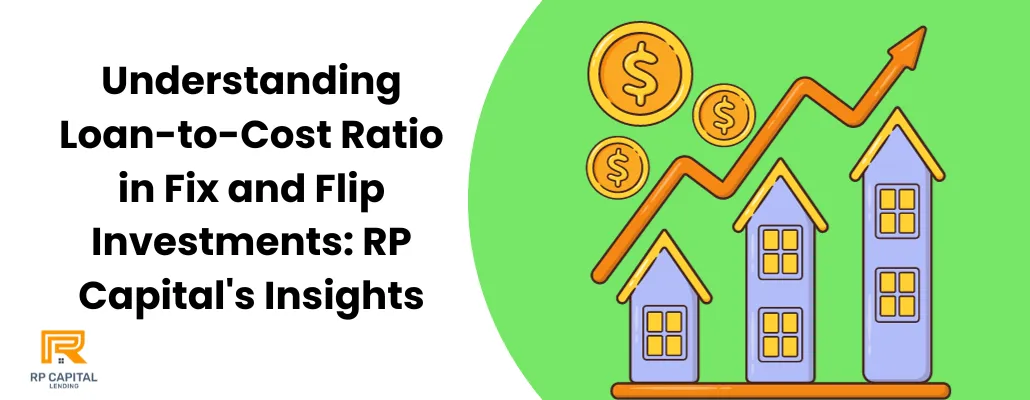Blog

Understanding Loan-to-Cost Ratio in Fix and Flip Investments: RP Capital's Insights
Imagine discovering a hidden lever in the world of real estate investing, one that could significantly tilt the odds of success in your favor. This isn't fantasy; it's the power of understanding the Loan-to-Cost (LTC) ratio in fix and flip investments.
Often overlooked yet crucially important, the LTC ratio is the key to unlocking potentially lucrative opportunities. In this insightful exploration, we'll dive deep into RP Capital's expert insights, unraveling the mysteries of LTC ratio and equipping you with the knowledge to transform your approach to real estate investment. Get ready to see the world of fix and flip through a whole new lens.
What is the Loan-to-Cost Ratio?
At its core, the Loan-to-Cost Ratio is a critical financial term used to assess the risk and viability of a real estate investment project. It compares the loan amount you'll need to the total cost of your project. For example, if you're considering a property that costs $250,000 and you need a loan of $200,000 to purchase and renovate it, your LTC ratio is 80% ($200,000 / $250,000).
Understanding this ratio is not just about crunching numbers. It's about understanding the level of risk you're taking on and how lenders view your project. A higher LTC ratio can mean more risk for both you and the lender, while a lower ratio indicates a more secure investment.
Why LTC Ratio Matters in Fix and Flip Investments:
Risk Assessment: The LTC ratio is more than a number; it’s a reflection of your financial strategy. A high LTC ratio might mean higher debt levels, indicating a riskier venture, whereas a lower ratio suggests a safer, more self-funded project.
Influencing Loan Approvals: Lenders scrutinize the LTC ratio closely. A lower LTC ratio often means a larger personal investment in the project, which can be a green light for lenders to approve your loan.
Strategic Financial Planning: Knowing your LTC ratio is key in outlining your financial strategy. It provides a clear picture of how much capital you should put down and how much you should borrow.
Benchmarking Success: Use the LTC ratio to set benchmarks for your project’s success. Understanding this ratio helps in setting realistic goals and expectations for your investment return.
LTC Ratio versus Other Financial Metrics:
While the LTC ratio is a vital tool, it doesn't operate in isolation. It should be used in conjunction with other metrics like the Repair Value (ARV) and Return on Investment (ROI). The ARV gives you an estimate of the property’s value post-renovation, and the ROI indicates the potential profitability of the project. A comprehensive investment strategy considers all these metrics to ensure a well-rounded approach.
RP Capital’s Expert Tips for Optimizing Your LTC Ratio:
Conduct Comprehensive Market Research: Before diving into a project, thorough research is paramount. Understand the property, the neighborhood, and the market trends.
Accurate and Realistic Budgeting: An accurate budget is your best friend in fix and flip investments. Ensure that every potential cost is accounted for to avoid surprises that could affect your LTC ratio.
Develop a Strong Contingency Plan: Unexpected costs are part and parcel of property flipping. A robust contingency plan can help manage these unforeseen expenses without derailing your LTC ratio.
Foster Relationships with Lenders: A strong rapport with your lenders can be a game-changer. It opens the door to potentially better loan terms and invaluable advice.
Regular Financial Reviews: Keep a close eye on your project’s financial health. Regular reviews can help you stay on top of your LTC ratio and make adjustments as needed.
Conclusion:
In the dynamic world of fix and flip investments, the Loan-to-Cost ratio stands as a beacon, guiding investors toward wise financial decisions. With the insights from RP Capital, this guide aims to equip you with the knowledge to navigate these waters skillfully. Remember, understanding your numbers is not just about avoiding pitfalls; it's about paving your path to success.
FAQs:
1. What’s a favorable LTC ratio for a fix and flip project?
Ideally, an LTC ratio should be between 70% and 80%. This range is generally seen as a good balance between personal investment and borrowed funds.
2. Can I secure a loan with a high LTC ratio?
Yes, though it might be more challenging. High LTC ratios are often seen as riskier, possibly leading to higher interest rates or more stringent lending terms.
3. How does the LTC ratio influence interest rates?
Typically, a lower LTC ratio can result in more favorable interest rates, as it's seen as less risky from a lender's perspective.
4. What are ways to reduce my LTC ratio?
Increase your upfront investment, find ways to reduce renovation costs, or consider a smaller loan to bring down your LTC ratio.
5. Is the LTC ratio more crucial than ARV in property flipping?
Both are critical. While LTC helps in managing finances and assessing risk, ARV gives an insight into the potential value and profitability of the project.
RP Capital Lending is a d.b.a of RP Capital Partners Inc (NMLS # 2469193) | Privacy Policy
Copyright © 2022. All Rights Reserved.
Disclaimer: Loans only apply to non-owner occupied properties. Rates, terms and conditions offered only to qualified borrowers, may vary upon loan product, deal structure, other applicable considerations, and are subject to change at any time without notice.

